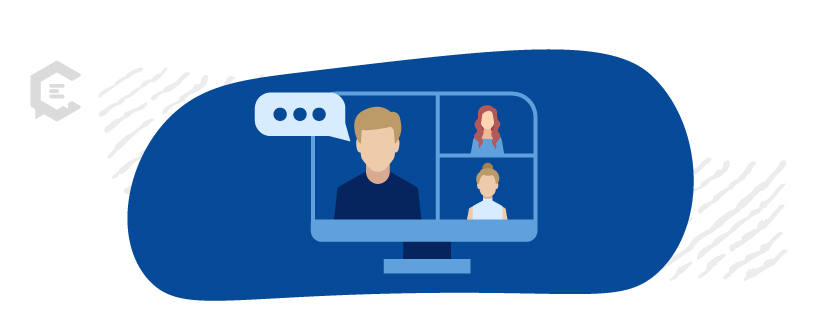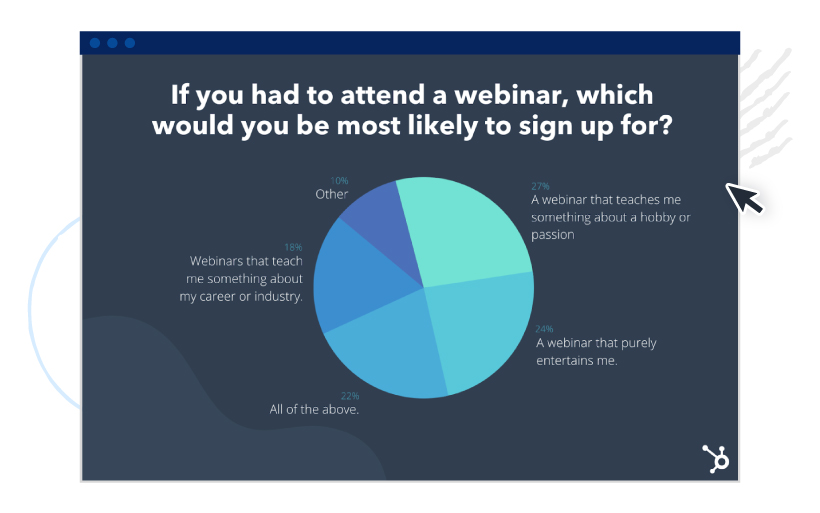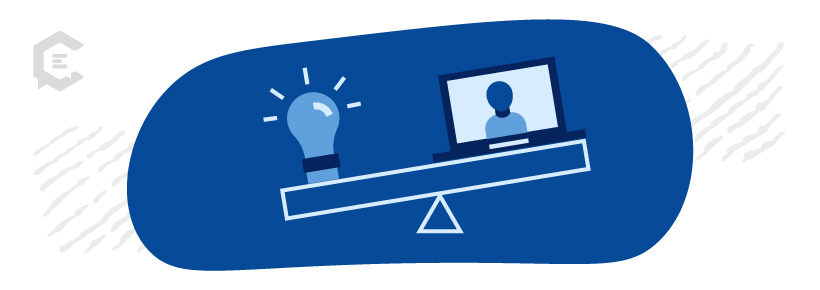A carefully developed webinar marketing strategy can propel your content marketing initiatives from good to great — but only with the right approach.
Webinars are powerful marketing tools. They allow you to reach a wider audience, improve your brand’s credibility, and generate high-value leads.
The best part is it’s also easier than ever to prepare and host your webinar. Thanks to modern conferencing apps, content marketing tools, and event promotion platforms.
This guide will show you how to plan, create, and execute a successful webinar content strategy.

Who Attends Webinars?
Most people who join webinars are business owners or executives. Additionally, people who want to further their careers, pursue their passions, or find entertainment.
As long as they have an internet connection, webinar attendees can be under any age, gender, or income group.
Statistics show that 27% of webinar attendees want to learn more about their passions or hobbies. 24% attend webinars to get entertained. While 18% attend as a way to grow their careers.

Image Source: HubSpot.com
Webinars are trending in business for their utility, impact, and low costs.
You can host webinars to build authority or pivot your business. It also serves to “humanize” your brand, increase sales, educate new customers, and increase buyer confidence.
Webinars also rose in popularity as an alternative to in-person events during the pandemic. Attendees can join a webinar from anywhere in the world through their devices.

Leveraging webinars in your content strategy
Use the strategies below to plan, host, and market a successful webinar:
1. Identify your webinar marketing goals
Specify your objectives for preparing and hosting a webinar.
Webinars are versatile, allowing you to achieve various business goals, such as:
- Generating more leads
- Educating or onboarding customers
- Building brand authority and loyalty
- Promoting products or services
- Publicizing new partnerships
- Raising brand awareness
- Humanize your brand and nurture leads
Understand your goals to determine the formats and topics you need to cover in your webinar. This will also help you decide which webinar platform and content distribution channels to use.
2. Choose the right presenters
After deciding on your webinar’s topics, find the right educators, influencers, and other subject matter experts as your presenters.
Inviting expert presenters not only improves the value and overall quality of your webinar content. You also leverage their reach to reel in more attendees and increase your webinar’s exposure when it goes live.
3. Build your webinar content
Work closely with presenters to put together a solid webinar script.
You don’t have to write everything word for word. To make the webinar more organic and authentic, create an outline with key talking points. Also, give your presenters some legroom to freely express their thoughts.
Apart from your webinar script, prepare any additional material you might need. This includes infographics, data visualizations, slideshow presentations, videos, and more.
If your webinar timeline is tight, outsource content creation to trusted freelancers and agencies. Just ensure that everyone is fully aware of your business goals and target audience.
4. Incorporate interactivity
When planning your webinar, allocate some time to engage and interact with your audience. Make them feel like they’re attending an actual, live event—not watching a pre-recorded video.
Here are five simple ideas to make your webinar more interactive:
- Interviewing select attendees
- Hosting a Q&A segment
- Tell attendees to do something (visit a page, download a resource, launch an app, etc.)
- Asking icebreaker questions
- Use interactive webinar tools (polls, quizzes, etc.)
5. Boost attendance with a concierge chatbot
Use a concierge chatbot to streamline the registration process and automate reminders for webinar attendees.
Statistics show that only 44% of registered users actually attend webinars live. Improve this through strategic follow-ups that remind attendees a few hours before the webinar starts.
Creating a concierge chatbot is a great way to do this. Use tools like MobileMonkey and ChatFuel to create chatbots for your webinar registration and automate follow-ups.
6. Pick the right webinar platform
Choose the perfect webinar platform according to your goals, budget, and timeline.
Think about the features you need to host your specific webinar and effectively convey your message. After that, look for the webinar platform that provides everything you need at the best price.
The top four webinar platforms for different ideas and budgets are:
- GoToWebinar
- Stealth Seminar
- ClickMeeting
- Zoom
7. Pay attention to what happens next
Design an enriching post-webinar experience that will help attendees remember your event.
A simple, yet effective approach is to offer downloadable content. For example, white papers, industry reports, eBooks, and templates. You can also promote exclusive offers and discount codes; especially if your webinar marketing goal is to generate sales.
Repurposing content into supporting content
Consider repurposing your webinar content for other campaigns.
For example, you can compile data visualizations to create infographics. Memorable quotes from presenters also make for effective tweets, Instagram posts, and authoritative snippets for blog posts.
Other ideas include:
- Siphoning ideas from your webinar Q&A to your FAQ page
- Building an online course with noteworthy clips from your webinar
- Transcribing a webinar segment into a blog post
- Offering a recorded version of your webinar as premium content
- Repurpose webinar videos for newsletters, social media, and video-sharing platforms
Best platforms for promoting webinars
Promote your webinar through online event and webinar discovery platforms like Eventbrite or Eventful.
You may also promote your webinar via traditional channels, like:
- Social media
- Content syndication websites
- Guest posts
- Online communities
- Podcasts
- Display ads
Another surefire strategy to drive up webinar attendance is to hire managed content distribution services.
ClearVoice, for example, can help you with all the stages of webinar promotions. We work with proven freelancers who create top-notch, share-worthy content pieces, along with trusted publishers who can help you reach a wider audience.

Frequently Asked Questions
Are webinars part of content marketing?
Yes, webinars are a critical part of modern content marketing. Webinars utilize the power of live videos to attract, engage, and convert potential leads in both the B2B and B2C landscapes.
What are the 4 marketing channels for promoting a webinar?
The top four marketing channels for promoting a webinar:
- Social media
- Newsletters
- Podcasts
- Website landing page
What is the best time to promote a webinar?
Statistics from GoToWebinar reveal that Tuesdays between 8-10 a.m. is the best time to promote webinars and generate registrations. Get the most attendees by promoting your webinar 3-4 weeks before the broadcast date.
How do you plan webinar content?
Plan webinar content by identifying your business goals, choosing your presenters, and understanding your audience. These three components will help you decide the formats, topics, and supporting content, you need for your webinar.
Use Webinars to Drive Marketing Success
Webinars are more than just content pieces. They’re entire, impactful experiences that can engage your target audience, solidify your authority, and exceed your content marketing goals.
Remember the tips above to build a successful webinar content strategy and reintroduce your brand in a more authentic and compelling light. If you need additional support with your content production, get in touch with us today!



